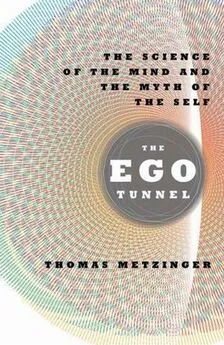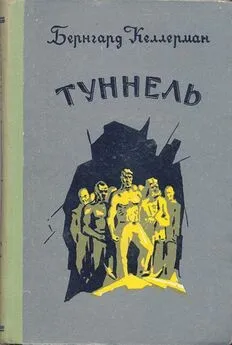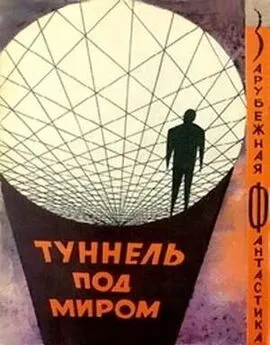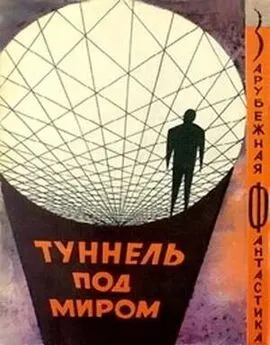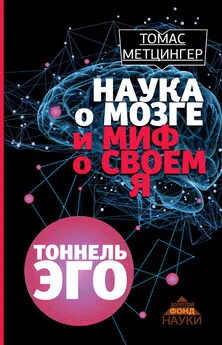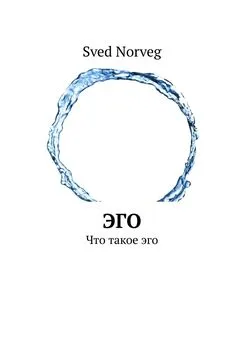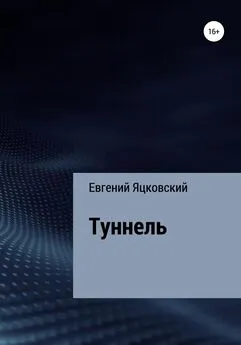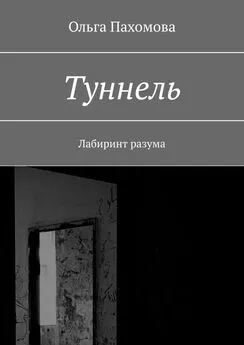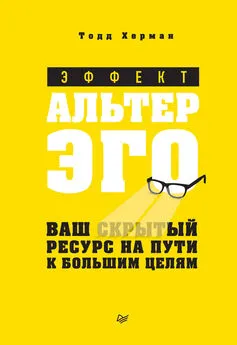Томас Метцингер - Туннель Эго
- Название:Туннель Эго
- Автор:
- Жанр:
- Издательство:неизвестно
- Год:неизвестен
- ISBN:нет данных
- Рейтинг:
- Избранное:Добавить в избранное
-
Отзывы:
-
Ваша оценка:
Томас Метцингер - Туннель Эго краткое содержание
Томас Метцингер — Туннель Эго
Thomas Metzinger — The Ego Tunnel. The Science Of The Mind and The Myth Of The Self
Перевод с английского: Вячеслав Михайлов v.v.mykhailov@gmail.com
http://www.nwethik.com
Туннель Эго - читать онлайн бесплатно полную версию (весь текст целиком)
Интервал:
Закладка:
2. See Patrick Wilken, «ASSC-10 Welcoming address,» in 10th Annual Meeting of the Association for the Scientific Study of Consciousness, 23–36 June 2006, Oxford, U.K., 6. At http://eprints.assc.caltech.edu/138/01/ASSC10_welcome_final.pdf.
3. See Thomas Metzinger, ed., Conscious Experience (Thorverton, UK, and Paderborn, Germany: mentis & Imprint Academic, 1995).
4. See the special issue on the neurobiology of animal consciousness in Consciousness and Cognition 14(1):1-232 (2005), in particular A. K. Seth et al., «Criteria for Consciousness in Humans and Other Mammals,» 119–139.
5. See Thomas Metzinger, ed., Neural Correlates of Consciousness: Empirical and Conceptual Questions (Cambridge, MA: MIT Press, 2000).
6. See Colin McGinn, «Can We Solve the Mind-Body Problem?» Mind 98:349–366 (1989). Reprinted in Ned Block et al., eds., The Nature of Consciousness: Philosophical Debates (Cambridge, MA: MIT Press, 1997); and Metzinger, «Introduction: Consciousness Research at the End of the Twentieth Century,» in Metzinger, ed., Neural Correlates of Consciousness (2000).
7. Antti Revonsuo, Inner Presence: Consciousness as a Biological Phenomenon (Cambridge, MA: MIT Press, 2006), 144ff.
CHAPTER 2
1. In philosophical parlance, a «zombie» is a hypothetical entity that behaves exactly like a person and is objectively indistinguishable from one, but has no inner awareness of anything. If zombies were at least logically possible, this could perhaps show that there is no entailment from physical facts to facts about consciousness.
2. See, for example, Rocco J. Gennaro, ed., Higher-Order Theories of Consciousness: An Anthology (Philadelphia: John Benjamins, 2004); and David Rosenthal, Consciousness and Mind (New York: Oxford University Press, 2006).
3. See S. P. Vecera & K. S. Gilds, «What Is It Like to Be a Patient with Apperceptive Agnosia?» Consciousness and Cognition 6:237–266 (1997).
4. A. Marcel, «Conscious and Unconscious Perception: An Approach to the Relations Between Phenomenal Experience and Perceptual Processes,» Cog. Psychology 15:292 (1983).
5. See, for example, G. Tononi & G. M. Edelman, «Consciousness and Complexity,» Science 282:1846-51 (1998); and Tononi et al., «Complexity and the Integration of Information in the Brain,» Trends Cog. Sci. 2:44–52 (1998). For an exciting recent application to the difference between waking and sleeping, see M. Massimini et al., «Breakdown of Cortical Effective Connectivity During Sleep,» Science 309:2228-32 (2005). For a popular description, see Edelman and Tononi, A Universe of Consciousness: How Matter Becomes Imagination (New York: Basic Books, 2000).
6. Thomas Metzinger, Being No One: The Self-Model Theory of Subjectivity (Cambridge, MA: MIT Press, 2003).
7. In Greek mythology, the analogy between sleep and death was even closer: Hypnos, the god of sleep, and Thanatos, the god of death, were twins, the sons of Nyx, the night. Morpheus, the god of dreams, was Hypnos' son. As in Shakespeare, to sleep, and possibly to die, is perchance to dream.
8. See V. A. F. Lamme, «Towards a True Neural Stance on Consciousness,» Trends Cog. Sci. 10(11):494–501 (2006); S. Dehaene et al., «Conscious, Preconscious, and Subliminal Processing: A Testable Taxonomy,» Trends Cog. Sci. 10(5):204–211 (2006).
9. A. Lutz, «Changes in the Tonic High-Amplitude Gamma Oscillations During Meditation Correlates with Long-Term Practitioners' Verbal Reports,» poster at the 9th ASSC conference, Pasadena, CA (2005); Lutz et al., «Long-Term Meditators Self-Induce High-Amplitude Synchrony During Mental Practice,» Proc. Nat. Acad. Sci. 101(46):16369-73 (2004). A good recent review is A. Lutz et al., «Attention Regulation and Monitoring in Meditation,» Trends Cog. Sci. 12(4):163–169 (2008).
10. Although I ultimately disagree with his theory of the «objective self,» perhaps the most beautiful and readable exposition of this problem and its application to self-consciousness can be found in chapter 4 of Thomas Nagel's The View from Nowhere (New York: Oxford University Press, 1986).
11. R. L. Gregory, «Visual Illusions Classified,» Trends Cog. Sci. 1:190–194 (1997).
12. Ernst Poppel, Mindworks: Time and Conscious Experience (New York: Harcourt Brace Jovanovich, 1988); E. Ruhnau, «Time-Gestalt and the Observer,» in Thomas Metzinger, ed., Conscious Experience (Thorverton, UK, and Paderborn, Germany: mentis & Imprint Academic, 1995).
13. R. M. Halsey & A. Chapanis, «Number of Absolutely Identifiable Hues,» Jour. OpticalSoc. Amer. 41(12):1057-58 (1951). For an excellent philosophical discussion, see D. Raffman, «On the Persistence of Phenomenology,» in Thomas Metzinger, ed., Conscious Experience (Thorverton, UK, and Paderborn, Germany: mentis & Imprint Academic, 1995).
14. Raffman, «On the Persistence of Phenomenology,» 295 (1995).
15. Clarence I. Lewis, Mind and the World Order (New York: Scribner's, 1929). See also Daniel C. Dennett, «Quining Qualia,» in A. J. Marcel & E. Bisiach, Consciousness in Contemporary Science (New York: Oxford University Press, 1988).
16. Diana Raffman, Language, Music, and Mind (Cambridge, MA: MIT Press, 1993).
17. P. Churchland, «Eliminative Materialism and the Propositional Attitudes,» Jour. Phil. 78(2):67–90 (1981).
18. Quoted after the extensively revised 1991 edition by M. David Enoch and Hadrian N. Ball, Uncommon Psychiatric Syndromes (London: Butterworth-Heinemann, 1991), 167.
19. I am grateful to Dr. Richard Chapman of the University of Utah's Pain Research Center for pointing out to me the concept of an «immunculus»: the network of natural autoantibodies targeting extracellular, membrane, cytoplasmic, and nuclear self-antigens. The repertoires of natural auto antibodies are surprisingly constant in healthy persons and, independently of gender and age, are characterized by only minimal individual variations.
CHAPTER 3
1. M. Botvinick & J. Cohen, «Rubber Hand 'Feels' Touch That Eyes See,» Nature 391:756 (1998).
2. K. C. Armel & V. S. Ramachandran, «Projecting Sensations to External Objects: Evidence from Skin Conductance Response,» Proc. Roy. Soc. Lond. 270:1499–1506 (2003).
3. M. R. Longo et al., «What Is Embodiment? A Psychometric Approach,» Cognition 107:978–998 (2008).
4. See Antonio Damasio, The Feeling of What Happens: Body, Emotion, and the Making of Consciousness (London: Vintage, 1999), 19. See also A. D. Craig, «How Do You Feel? Interoception: The Sense of the Physiological Condition of the Body,» Nat. Rev. Neurosci. 3:655–666 (2002) and «Interoception: The Sense of the Physiological Condition of the Body,» Curr. Opin. Neurobiol. 13:500–505 (2003).
5. For an excellent recent review-including a new, empirically informed synthesis-of the classical intuition of David Hume (that the self is just a bundle of impressions and everything can be explained «bottom-up») as opposed to the classical Kantian intuition (self-consciousness is a necessary prior condition for experiencing the body as a whole and everything must be explained «top-down»), see F. De Vignemont et al., «Body Mereology,» in Gunther Knoblich et al., eds., Human Body Perception from the Inside Out (New York: Oxford University Press, 2006).
6. The terminology was never entirely clear, but it frequently differentiated between an unconscious «body schema» and a conscious «body image.» The body schema (a notion introduced in 1911 by Sir Henry Head and Gordon Holmes, two British neurologists) would be a functional entity, providing an organized model of the bodily self in the brain, whereas the body image would also include our conscious perceptions of our own body as well as thoughts about and attitudes toward it. For a philosophical perspective on the conceptual confusion surrounding both notions, see Shaun Gallagher, How the Body Shapes the Mind (New York: Oxford University Press, 2005). For an excellent review of the empirical literature, see A. Maravita, «From 'Body in the Brain' to 'Body in Space': Sensory and Intentional Components of Body Representation,» in Knoblich et al., Human Body Perception (2006).
7. A. Maravita & A. Iriki, «Tools for the Body (Schema),» Trends Cog. Sci. 8:79–86 (2004). An excellent recent overview is A. Iriki & O. Sakura, «The Neuroscience of Primate Intellectual Evolution: Natural Selection and Passive and Intentional Niche Construction,» Phil. Trans. R. Soc. B 363:222941 (2008).
8. See A. Iriki et al., «Coding of Modified Body Schema During Tool-Use by Macaque Post-Central Neurons,» Neuroreport 7:2325-30 (1996); and Maravita & Iriki, «Tools for the Body (Schema)» (2004).
9. J. M. Carmena et al., «Learning to Control a Brain-Machine Interface for Reaching and Grasping by Primates,» PLoS Biology 1:193–208 (2003).
10. Here is how Iriki and Sakura put this important point: «If external objects can be reconceived as belonging to the body, it may be inevitable that the converse reconceptualization, i.e., the subject can now objectify its body parts as equivalent to external tools, becomes likewise apparent. Thus, tool use may lead to the ability to disembody the sense of the literal flesh-andblood boundaries of one's skin. As such, it might be precursorial to the capacity to objectify the self. In other words, tool use might prepare the mind for the emergence of the concept of the meta-self, which is another defining feature of human intelligence.» See Iriki & Sakura, «The Neuroscience of Primate Intellectual Evolution,» 2232 (2008).
11. See O. Blanke & T. Metzinger, «Full-Body Illusions and Minimal Phenomenal Selfhood,» Trends Cog. Sci. 13(1):7-13 (2009).
12. See T. Metzinger, «Out-of-Body Experiences as the Origin of the Concept of a 'Soul,'» Mind and Matter 3(1):57–84 (2005).
13. E. R. S. Mead, The Doctrine of the Subtle Body in Western Tradition (London: John M. Watkins, 1919).
14. It is important to be clear about the potential ontological conclusions: Even if a fully reductive explanation of all subtypes of OBEs should be achieved-and even if my hypothesis about the history of the concept of a soul is correct-it still remains logically possible that souls do exist. True, we would no longer need the concept of a soul for the purposes of science or philosophy; it would no longer figure in any rational, data-driven theory about the human mind. Logical possibility is something very weak, but it is hard to prove the nonexistence of something, and it always remains possible that one day we will discover a new sense in which the soul is not an empty concept at all.
15. It is interesting to note how the earliest historical meaning of the word «information» in English was the act of informing, or giving form or shape to the mind. What I call the «self-model» is exactly this: the «inner form» an organism gives to itself, the shaping of a mind.
16. Susan J. Blackmore, Beyond the Body: An Investigation of Out-of-theBody Experiences (London: Granada, 1982).
17. In addition to Beyond the Body, see S. Blackmore, «A Psychological Theory of the Out-of-Body Experience,» Jour. Parapsychol. 48:201–218 (1984); and S. J. Blackmore, «Where Am I? Perspectives in Imagery and the Out-of-Body Experience,» Jour. Mental Imagery 11:53–66 (1987).
Читать дальшеИнтервал:
Закладка:
